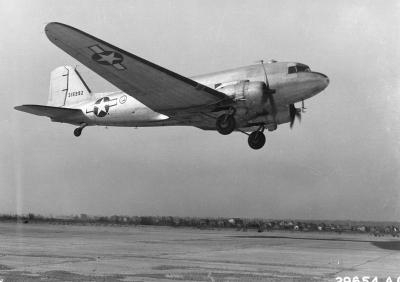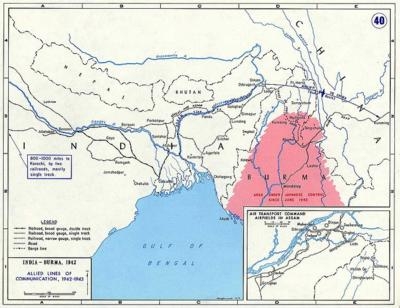Flying the Hump
In March 2022, seventy-year-old Eve Coulson made the 2,538-nautical-mile journey from New Jersey to California for purpose of visiting Moon Fun Chin, her 109-year-old Chinese-born "uncle.” As far as Ms. Coulson knows, Mr. Chin is one of the few surviving pilots who flew the Hump—a trans-Himalayan air-route via which munitions and other wartime supplies were delivered to Chinese combatants struggling to free their homeland from invading Japanese forces during the Second World War.

Peter J. Goutiere, who turned 108 on 28 September 2022, is another surviving Hump pilot. He, along with Chin and Coulson's father, Ursel Elbert Coulson, were pilots for the China National Aviation Corporation (CNAC), a Sino-U.S joint-venture established in 1929.
Because flight-training was easier to come by Stateside, most CNAC pilots were American. Conversely—as the curricula of early 20th Century American educational institutions were light on courses in Mandarin Chinese—the majority of CNAC co-pilots and radio operators were Chinese.
"It's great to be part of the group that flew over the Hump during WWII, and to still be around for the anniversary," Mr. Goutiere, who flew 680 Hump missions, remarked.
Japanese troops began pressing into China’s northeastern region on 18 September 1931, and launched a full-scale invasion of the Chinese mainland in July 1937. Four years later, forces of the Japanese Imperial Navy attacked Pearl Harbor, thereby precipitating American involvement in WWII. American industrial and military might bolstered China’s resistance against the Japanese invader, and slowly but unwaveringly advanced the Chinese cause throughout the Second World War’s Sino-Burmese-Indian Theater.
Initially, U.S. wartime and humanitarian supplies were transported to China via the Burma Road, a 717-mile mountain thoroughfare built during Burma’s British Colonial period for purpose of conveying supplies to China during the Second Sino-Japanese War. The road was closed, however, following Burma’s submission to Japan in May 1942.
To support China throughout the remainder of the Second World War, the India-China Division of the Air Transport Command (ATC) of the U.S. Army Air Corps and the CNAC worked together, pooling aircraft and aviators to airlift supplies from Assam in India to southwestern China’s Yunnan and Sichuan provinces. Pilots crossing the Gaoligong and Hengduan ranges of the southern Himalayas likened the towering peaks to the humps of a colossal camel, thereby unwittingly saddling the air-route with the unflattering, if not apposite, Hump moniker.
High altitude, perilous weather, and Japanese fighter planes were the principal dangers faced by the pilots flying the Hump. Between June and December 1943, the ATC's India-China Division lost 155 aircraft, 168 crew members, and an undisclosed number of passengers along Hump routes. In all, over six-hundred Allied aircraft and their crews perished crossing the Himalayas in support of China’s struggle against Japan. In his 1964 memoir Over the Hump, ATC division commander William Henry Tunner asserted: "Flying the Hump was considered as hazardous as flying a combat mission over Germany.”
Hump routes covered vast and varied geographical regions, the meteorological peculiarities of which subjected pilots to conditions ranging from torrential rains in the tropical south, to dust-storms in high inland deserts, to savage blizzards in the mountainous north.
The most tragic date in the Hump’s austere history was 06 January 1945, when 86-knot winds created powerful mountain waves that claimed 15 aircraft and the lives of their crews and passengers.

Personnel who survived crash-landings along Hump routes seldom emerged alive from the mountains, succumbing to exposure, wounds, starvation, or Japanese attacks. Eve Coulson’s father, however, proved an exception to the Hump’s lurid statistical probabilities. After engine failure sent him and his crew bailing out of their C-47 on 31 August 1944, the senior Coulson found himself alone in the dense jungles of northern Burma. For three days, he sustained himself by dint of stealth and woodcraft until he found a village, the leaders of which assisted and eventually delivered him to an ATC search party. Asked if he’d grown famished during his ordeal, Coulson confided that hunger hadn’t much bothered him on account of he’d subsided on leeches. Noting his rescuers’ incredulous looks, the airman added: “Hell fire, they were eating me. Why shouldn’t I eat them? I was just getting my own blood back.” Mr. Coulson was the sole member of his crew to survive the
incident.
Every American airman who plied his expertise and bravery to China's resistance against Japan received a "passport to safety" from the then Chinese government. Subject passport comprised a strip of silk emblazoned with Chinese characters reading: "This is a foreigner who helps China to fight. Be you military or civilian, please help and protect him or her." The tactic’s simplicity and startling success compelled Tunner to declare: "Once in China, the airmen would find nearly all natives friendly and most helpful."
Thanks to the concerted efforts of the ATC and the CNAC, more than 800,000-tons of military and humanitarian supplies were airlifted to China between 1942 and 1945. The provisions supported not only indigenous Chinese forces, but the Flying Tigers—the storied American Volunteer Group founded and commanded by Claire Chennault. The Flying Tigers and their Curtiss P-40 Warhawk fighters served as an ad hoc air force and directly resisted Japanese aerial incursions into China. Years after the Second World War’s conclusion, at a Washington ceremony honoring the Flying Tigers, Chennault remarked to Tunner: "If it hadn't been for you and your convictions and your fine ATC organization, we wouldn't have won the war in China.”
 ANN's Daily Aero-Term (05.07.25): Terminal Radar Service Area
ANN's Daily Aero-Term (05.07.25): Terminal Radar Service Area ANN's Daily Aero-Linx (05.07.25)
ANN's Daily Aero-Linx (05.07.25) Classic Aero-TV: Anousheh Ansari -- The Woman Behind The Prize
Classic Aero-TV: Anousheh Ansari -- The Woman Behind The Prize NTSB Prelim: Bell 206B
NTSB Prelim: Bell 206B Airborne-NextGen 05.06.25: AF Uncrewed Fighters, Drones v Planes, Joby Crew Test
Airborne-NextGen 05.06.25: AF Uncrewed Fighters, Drones v Planes, Joby Crew Test




